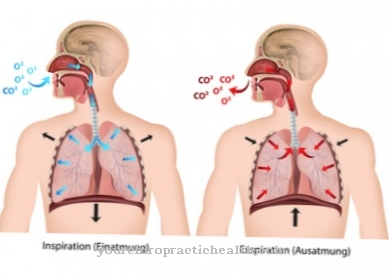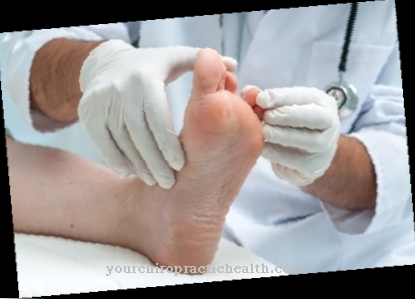Muscle building means growth of the muscles, caused by increased stress, for example during physical work, sport or special muscle training.
In today's industrialized nations, muscle gain is usually wanted, which is expressed in the numerous fitness studios and sports facilities. While moderate muscle gain is not pathological, there are numerous muscle contraction diseases.
What is muscle building?

Muscle building or muscle growth refers to the increase in volume of the musculature of the musculoskeletal system, the striated skeletal muscles. Your muscle tissue consists of fine fibers that ensure the contraction of the muscles. Up to 50 of these fibers form a muscle fiber bundle.
Within a muscle fiber there are longitudinally arranged structures, the myofibrils. This is where the myofilaments are located at the molecular level. They consist of the protein molecules actin, myosin and tropomyosin. The regular arrangement of the molecules creates the typical transverse stripes of the skeletal muscles.
A muscle can basically be built up or increased in volume in two different ways. Today, it is scientifically understandable that hypertrophy is the enlargement of the muscle cross-section by increasing the thickness of the individual muscle fibers. Animal experiments and observations on bodybuilders have shown, however, that the formation of new muscle fibers, known as hyperplasia, can also be responsible for the growth of a muscle.
Hypertrophy is caused by stress that goes beyond what is normal for the individual in question. The increased activity exerts a stimulus on a molecular level. More protein is produced, which in turn leads to an increase in the volume of the cells and thus the cross-section of the muscle fiber.
The development of the muscles can also be stimulated through a protein-rich diet or the intake of growth hormones, anabolic steroids. In this case, growth occurs only through hypertrophy.
Function & task
Both types of muscle growth serve the body as a protective function against overloading the muscles. By increasing the cross-section of the fibers of a muscle or the number of fibers, the load is distributed over a larger cell mass. The individual muscle fiber is relieved.
At the same time, the strength of the muscle increases as it increases in proportion to the cross-section of the muscle fiber. This also relieves the individual fiber. The onset of sore muscles when overworked warns against early further use of the affected muscle.
However, other components also play a role in the strength development of a muscle. Even small people can have great muscle strength. Among other things, it is also dependent on intramuscular coordination and biomechanical principles such as the laws of levers. Well-developed and proportioned muscles are a prerequisite for the effortless and damage-free functioning of the musculoskeletal system.
In addition to building muscles, sports such as yoga or tai-chi promote functionally trained muscles. By purposefully and consciously controlling the physical movements, they promote intramuscular coordination.
The skeletal muscles perform various tasks in the human body. Not only does it allow the skeleton to move through its ability to contract and relax. Since it constantly receives light impulses from the central nervous system, which permanently put the muscles in a basic tension, the muscle tone, it also guarantees that the body is effortlessly maintained.
Another function of the skeletal muscles is to participate in the body's energy balance. Only the basic tone already generates 25% of the energy expenditure and thus body heat. This value increases considerably with movement. Although some of the energy is used up in the moving muscles, as a side effect they release additional heat.
You can find your medication here
➔ Medicines for muscle weaknessIllnesses & ailments
The increase in the muscles of the musculoskeletal system is usually desirable and not pathological. A testimony to this is the high number of visitors to bodybuilding studios and recreational athletes. On the other hand, a decrease in muscles leads from mild discomfort to serious illness.
Muscles build themselves up and down again in a constant process, depending on whether the person uses the respective muscle more or less in relation to the normal load for him.
If muscles are not used for a longer period of time, the volume is visibly reduced, resulting in tissue or muscle atrophy. This reduces the diameter of the individual muscle fibers.
This already falls within the experience of the average person today. Particularly people who lack natural physical activity in their professional and everyday lives complain of musculoskeletal complaints.
The muscles lack an even, coordinated load. The less stressed muscles recede and relax, other muscles cramp up to enable relieving postures. In the long run this leads to complex, serious consequential damage throughout the body. This can be prevented through exercise or targeted muscle training.
Muscle wasting due to lack of activity, the so-called Inactivity atrophy can be clearly seen when immobilized with a plaster cast. However, through targeted training, the affected muscles can easily be rebuilt. Serious atrophy of inactivity is present with complete paralysis. The transmission of impulses from the motor nerve cells to the muscles is interrupted. Atrophy due to a lack of gravity is observed in space travelers.
Among other things, malnutrition, metabolic disorders, alcoholism or hormonal changes can also trigger muscle wasting. Other severe forms of muscle wasting, muscular dystrophies, are hereditary. Mutations in the genome result in a deficiency or a defect in the muscle-building protein dystrophies. This leads to the degeneration of the muscles with progressive muscle weakness and muscle wasting.
Various diseases of the nervous system can also lead to a decrease in muscle mass. The neural and spinal muscular atrophies should be mentioned in particular.
On the other hand, excessive muscle building can also lead to serious illnesses. Extreme sports or bodybuilding, in which individual muscle groups are extremely enlarged, but others are neglected, can include Cause damage to posture.
The use of anabolic steroids, doping, to support muscle building, leads to serious consequential damage in any case if taken for a long time. Extensive organ damage can always be observed, especially the cardiovascular system, the liver and the sexual organs. Studies also show a four to five times higher mortality rate.



























